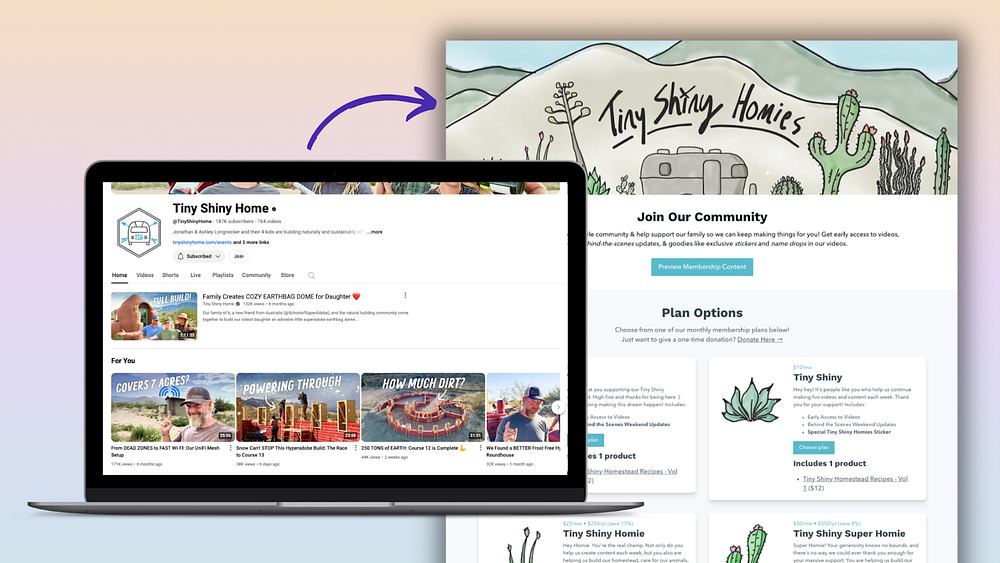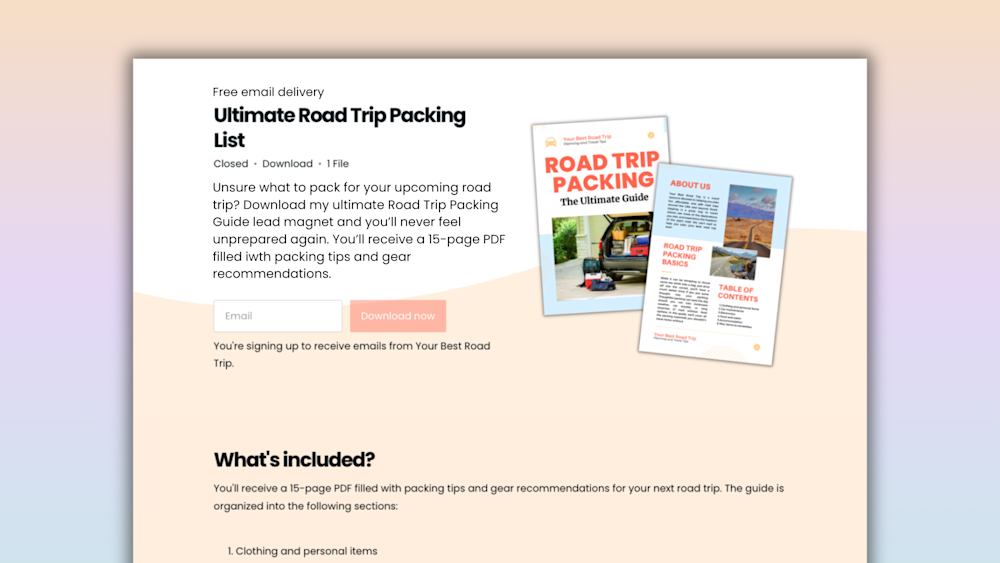With 2.7 billion monthly active users, it's no secret Facebook is one of the biggest social media marketing tools available to creators and entrepreneurs.
Facebook ads offer so many options for audience targeting, campaign objectives, and creative that they can feel intimidating, especially for small businesses.
Sometimes, it might even feel like throwing spaghetti (and your ad budget) at the wall to see what sticks.
Done right, though, Facebook ads can be a powerful and cost-effective way to move potential customers through the buyer's journey.
Today, we're covering how to turn cold leads into paying customers with a Facebook sales funnel. If you want to make Facebook ads a part of your marketing strategy, keep reading.
But first, what exactly is a Facebook sales funnel? And why should you build one?
What is a Facebook sales funnel? And why should you use one?
A Facebook sales funnel is the process of capturing leads through Facebook ads and nurturing them until they're ready to purchase.
Your sales funnel maps the journey that a potential customer takes from their first interaction with your brand until they become a paying customer:
Facebook ads let you serve different ads to customers depending on where they fall in the sales funnel. (We'll cover how to craft ads for each stage later on.)
There are a lot of ad channels out there, though. What makes Facebook such a powerful tool for targeting, nurturing, and converting the leads in your funnel?
First and foremost, Facebook's size and reach make it a top choice for advertisers across industries.
93% of social media advertisers are using Facebook Ads, and advertisers around the globe spent over $67.37 billion on Facebook Ads in 2019 alone, second only to Google ads.
With such a huge user base, it might seem that advertising on Facebook would be too broad to be effective. But Facebook offers powerful audience targeting tools to help advertisers show their ads to the right people.
And when you serve people ads that are relevant to their interests and pain points, they'll be more likely to click on them. (Which is probably why the average Facebook user clicks on 11 ads per month, or one every three days.)
So how do you get your ads in front of that super-relevant audience?
When you create a new campaign on Facebook, you can create a new targeted audience based on characteristics like:
-
Location: Local businesses can target their own cities or serve ads to nearby neighborhoods.
-
Age: If your audience has a broad age range, you can segment your ads accordingly.
-
Interests: Based on users' “likes” and Facebook activity, Facebook can highlight potential customers. For example, a user who lists digital marketing as an interest might be a great fit for your new online marketing ebook.
-
Demographics: Additional details such as education level or relationship status can help you target your ideal customer.
But what if you already know exactly who you want to target? That's where Facebook Custom Audiences comes in. You can upload an existing list of contacts, such as your email list or website visitors, then show targeted ads to those users.
Custom Audiences are especially useful when you have leads who have signed up for your email list or downloaded a lead magnet but haven't made a purchase yet.
Last but not least, one more powerful targeting tool for Facebook sales funnels is Lookalike Audiences.
Lookalike Audiences help you find people similar to your current customers. You take one of your Custom Audiences (like your existing customers or email list) and tell Facebook to find more people that "look like" that audience.
With almost 1.79 billion daily active users, chances are Lookalike Audiences will help you get your ads in front of plenty of users you wouldn't have reached otherwise.
OK, now you know what makes a Facebook sales funnel one of the most effective ways to use social media to sell more digital products. Next, let's dive into how to build that funnel and start turning leads into customers.
How to build a Facebook sales funnel in 3 steps
1. Build brand awareness with high-quality content
To make the most of your Facebook ads, show different content and messaging to different audiences based on where they are in your funnel:
The first step to turning a cold audience into loyal customers is to let them know that you exist. Your number one goal in this stage should be to educate others about your business and improve your brand's name recognition.
At the top of the funnel (also called TOFU -- yum), buyers are in the awareness stage. They know they have a problem to solve, but they're not sure where to start. They have questions like:
-
What should I know about the problems I'm trying to solve?
-
What brands out there solve problems like mine?
-
What kinds of products and services can solve my problems?
Make sure you segment your audience based on where they fall in the marketing funnel.
Here's why: 91% of consumers are more likely to shop with brands who provide them with relevant offers and recommendations, and that includes recognizing how familiar they are with your brand and product.
You don't want to show top-of-funnel ads to leads who are ready to convert, and you don't want to hit a cold audience with a hard sell.
And there are plenty of leads-to-be waiting to discover you: 78% of American consumers between the ages of 18 and 34 say they’ve discovered products on Facebook.
But how do you find them?
To target the right audience at the awareness stage, take advantage of Facebook's super in-depth targeting tools we talked about earlier, like interest and demographic-based targeting and Lookalike Audiences.
If you already have a solid email list, you can use the Lookalike Audience feature here to target people similar to your existing followers and customers.
Targeting isn't the only way Facebook ads let you get specific. When you set up a new Facebook ad campaign, it asks you to choose your Facebook marketing objective:
At the awareness stage, you have two objectives to choose from:
-
Brand awareness: Reach people more likely to recall your ads and increase awareness for your brand.
-
Reach: Show your ad to the maximum number of people in your audience.
Once you choose your objective, you need to choose the content for the ad itself.
In our guide to using Facebook ads to sell online courses, expert Mojca Zove advises starting with one of your most popular blog posts, like in this KickoffLabs example:
Mojca also recommends including copy that offers a teaser about the blog post and finishing with a call-to-action (CTA) that encourages readers to learn more.
Even if they don't click through to your website the first time they see an ad from you, people who see your ads might "Like" your page or click to see the rest of your Facebook profile.
Every touch point on the customer journey matters, so make sure you have strong organic content on your Facebook page.
If you're not sure where to start -- or don't have enough hours in the day -- a social media management tool can help you save a lot of time as you build up your social media presence.
OK, now that you've introduced your brand to a new audience, it's time to move on to the next step in the funnel: The consideration stage.
2. Showcase your value with social proof and lead magnets
In the middle of the funnel (a.k.a. MOFU), prospective buyers are in the consideration stage, researching and comparing a handful of products. They know what their problem is, and they know there are multiple options out there to solve it.
Your job is to make them realize that your product is the best option.
In this stage of the ad funnel, buyers are asking:
-
Of the handful of brands I like, which one should I purchase from?
-
What products do they offer?
-
How are their products different from other companies’ products?
This is your product's time to shine. Address your audience's pain points directly and give them the information they need to choose your product confidently.
For example, customer testimonials are a way to show your product's value, like in this ad from Prose:
Social proof -- showing others' results from your product or service -- shows warm audiences what sets your brand apart. And it works, since 91% of 18 to 34 year-olds trust online reviews as much as personal recommendations.
Lead magnets are another great way to set your product apart during the consideration stage. A lead magnet is any offer -- often a resource in the form of a downloadable PDF or other digital download -- that users receive in exchange for providing their information.
(If you want to use a lead magnet in your Facebook ads but don't have a lot of time on your hands, take a look at our guide on how to create a lead magnet in 90 minutes or less.)
For example, HubSpot knows that I'm interested in marketing, and I've interacted with their content before, so they serve me ads like this Signature Generator lead magnet:
And this free social media course:
HubSpot offers me interactive content and valuable resources in exchange for my clicking through to their landing page and signing up.
Once I give them my contact information, they can enter me into an email marketing campaign to continue moving me down their sales funnel.
Your goal at this stage is to drive as much traffic to your site as possible. The more enticing the lead magnet, the more likely your audience is to click through to your landing page:
If you're looking for a place to host your digital downloads -- lead magnets and products for sale alike -- check out Podia, an all-in-one platform for hosting, selling, and promoting your digital products. Get a free 30-day trial here.
Alright, let's loop back around to the technical side before we move on to the bottom of the funnel.
When you select your objectives during your Facebook ad setup, these are the best choices for your ads in the consideration stage:
-
Traffic: Increase the number of visits to your website.
-
Engagement: Get more people to see and engage with your post or page.
-
Video views: Use video ads that show product demos or customer testimonials.
-
Lead generation: Collect lead information, such as email addresses, from people interested in your business.
-
Messages: Get more people to start conversations with your business over Messenger.
OK, your leads are heating up and getting ready to convert. Keep reading to learn how to use your Facebook sales funnel to get them over the finish line.
3. Convert leads to customers with remarketing and retargeting
At the bottom of the funnel (BOFU), we're warming up and getting ready to turn your leads into customers.
It's time to pull out your (not-so-)secret Facebook ads weapon: Remarketing and retargeting.
Have you ever been looking at a pair of shoes on an ecommerce site, then clicked over to Facebook, just to see those same shoes advertised on your newsfeed? That's retargeting, and it's all thanks to the Facebook Pixel.
The Facebook Pixel is "a piece of code for your website that lets you measure, optimize and build audiences for your ad campaigns". It helps you retarget leads who have visited your website and engaged with your content.
Here's how the Facebook Pixel works:
-
You add the pixel to your website code.
-
The pixel tracks which products visitors are interested in.
-
You use the pixel to target and remarket to those visitors via Facebook ads.
-
Visitors click the ads and come back to your website to complete their purchase.
It may seem a little heavy-handed, but when you make retargeting a part of your digital marketing strategy, it works.
Take Sonos, for example. To promote its PLAYBASE speaker, Sonos ran a multi-tier Facebook ad campaign that used Lookalike Audiences, video ads, link ads, and Facebook dynamic ads.
The second phase of their campaign used retargeting to reach users who had already engaged with Sonos' content.
The results? Sonos reached 19 million people and saw 19 times the return on ad spend. And when you're working with pay-per-click (PPC) ads, every dollar counts.
When you use retargeting in your own bottom of the funnel campaign, remember that you're addressing an audience who's ready to purchase.
Now's the time to:
-
Add more social proof
-
Demonstrate your product’s value with a case study
-
Introduce an exclusive offer or heavy discount
-
Make the hard sell or direct sales pitch
Facebook ads expert Mojca Zove recommends that you “talk about pains and provide solutions and your CTA. Be specific with your CTA and tell your audience exactly what to do”.
For example, Obe Fitness served this Facebook ad on my feed:
I've visited Obe Fitness' site before, and even started (then abandoned) their signup form. Knowing I was close to converting, they retargeted me with a triple whammy -- a video ad, a special discount code, and a CTA to sign up.
Decision-stage ads are also the best time to ramp up the urgency in your copy, like online marketing expert Amy Porterfield does in this ad for her Courses That Convert program:
Amy's ad copy highlights her program's $3,000 value, plus the end results you can expect from joining her program.
Emoji and copy like "the clock is ticking" ramp up the urgency, so customers at the bottom of Amy's sales funnel have no reason not to sign up for her program as soon as they see the ad.
Basically, at this stage of the funnel, your ads should make converting a no-brainer for your audience.
To set that goal on the technical end of things, you'll want to choose objectives that encourage your most engaged leads to purchase or sign up for your product or service ASAP.
Your best objective options are:
-
Conversions: Get more people to use your website, Facebook app, or mobile app. You can use the Facebook Pixel to track and measure your conversion rate.
-
Catalog Sales: Show products from your catalog (a.k.a. the products on your website) based on your target audience.
With those objectives in place -- and the fully fleshed out Facebook sales funnel you've created so far -- your warmest leads will convert to customers in no time.
3 steps to build your Facebook sales funnel
With the right strategy, Facebook ads can be a powerful tool to turn cold leads into loyal customers.
Follow these three steps to set up your Facebook sales funnel:
-
At the top of the funnel, focus on building brand awareness. Help users get to know your brand by sharing some of your best content.
-
In the middle of the funnel, showcase your product's value. Use testimonials and lead magnets to highlight how your product meets your customers' needs.
-
At the bottom of the funnel, go for the hard sell. Use heavy discounts, a sense of urgency, or exclusive offers to push your lead across the finish line.
Keep your buyers' awareness and pain points in mind every step of the way, and you'll be well on your way to a Facebook sales funnel that makes your conversion rates soar.



